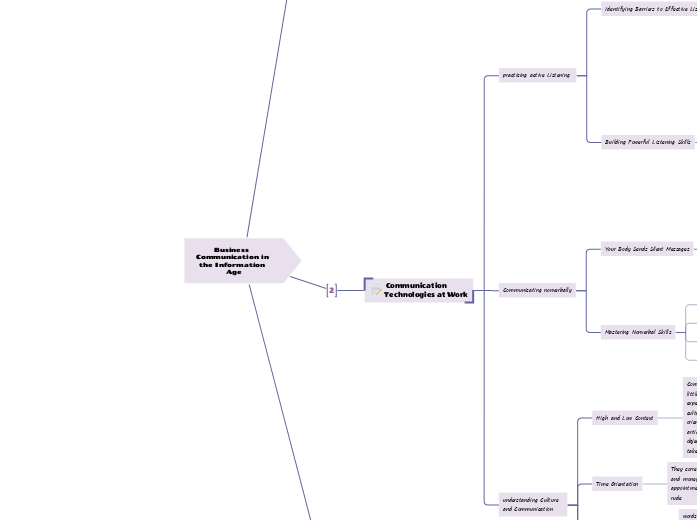Business
Communication in
the Information Age
1
Thriving in a Digital, Social,
and Mobile Workplace
Succeeding With twenty-First-Century
Skills
Communication Skills and Career Success
Superior communication skills will make you marketable in the workplace of the future regardless of the economic climate. When competition is fierce, excellent communicators immediately stand out. In poll after poll, communication tops recruiters’ wish lists. In one recent survey of job postings, written and oral communication ranked first among the five most desirable attributes in job seekers, ahead of management, leadership, problem-solving, and teamwork skills. Your ability to communicate is a stepping-stone to great job opportunities.
Why Communication and Other Social Skills Matter
the average employee spends almost 12 hours per week answering e-mails at the office
and another 5 hours from home. Work team members
can collaborate virtually, often across vast distances. In such a networked environment,
writing, speaking, and other professional skills count more than ever.
Meeting the Challenges of the Information
Age Workplace
Disruptive technologies and social media
The new sharing economy (think Uber or Lyft) emerged thanks to platforms accessible with smartphone apps and have radically transformed whole industries. Airbnb has disrupted the hospitality industry. Social media continue to connect people around the world.
Remote work and 24/7/365 availability
Even before the COVID-19 pandemic forced 66 percent of U.S. employees to work from home at least part-time. high-speed and wireless Internet access had freed 30 percent of workers from conventional jobs in physical offices.
2
Communication
Technologies at Work
practicing active Listening
Identifying Barriers to Effective Listening
Psychological barriers. Everyone brings to the communication process a unique set of cultural, ethical, and personal values. Each of us has an idea of what is right and what is important. If other ideas run counter to our preconceived thoughts, we tend to tune out speakers and thus fail to receive their messages.
Language problems. Unfamiliar words can destroy the communication process because they lack meaning for the receiver. In addition, emotion-laden, or charged, words can adversely affect listening.
Thought speed. Because listeners can process 450 words per minute, but in reality speakers talk about 125 to 175 words per minute, we can become bored and allow our minds to wander
Building Powerful Listening Skills
Stop talking. If you are the brash chatty type who dominates conversations, try to break the habit by letting others talk without interrupting.
Adopt an empathic attitude. Effective listening requires empathy, the ability to understand other people’s perspectives and emotionally respond to their experiences
Communicating nonverbally
Your Body Sends Silent Messages
Eye Contact. Most of us cannot look another person straight in the eyes and lie. Good eye contact enables the message sender to see whether a receiver is paying attention, showing respect, responding favorably, or feeling distress.
Facial Expression.To hide their feelings, some people can control these expressions and maintain so-called poker faces.
Mastering Nonverbal Skills
Establish and maintain eye contact.
Improve your decoding skills.
Interpret nonverbal meanings in context.
Use posture to show interest
understanding Culture
and Communication
HIgh and Low Context
Communicators in low-context cultures depend little on the context of a situation and shared
experience to convey their meaning. Low-context cultures tend to be linear, analytical, and action oriented. Business communicators stress clearly articulated messages that they consider to be objective, professional, and efficient. Words are
taken literally.
Time Orientation
They correlate time with productivity, efficiency, and money. Keeping people waiting for business appointments is considered a waste of time and rude
Communication Style
words are very important, especially in contracts and negotiations. People in high-context cultures, on the other hand, place more emphasis on the surrounding context than on the words describing a negotiation.
Power Distance
One important element of culture is power distance, The Power Distance Index measures
how people in different societies cope with inequality—in other words, how they
relate to more powerful individuals.
Summary of Learning Outcomes
Describe how communication skills fuel career success in a challenging digital age
marketplace.
SuIn an era of automation, augmented reality, and artificial intelligence, communication and other interpersonal skills can
future-proof well-trained workers.btopic
Workers communicate more than ever; many collaborate in teams, which means that even technical fields require excellent communication skills.
Employers expect new-hires and other employees to project a professional image and possess superior interpersonal skills, including oral and written communication.
Discuss how effective nonverbal communication can help you build your credibility
and advance your career.
Study nonverbal cues such as eye contact, facial expression, and posture that send silent, highly believable messages.
Understand that how you use time, space, and territory is interpreted by the receiver, who also reads the eye appeal of your business documents and your personal appearance.
Master nonverbal skills by keeping eye contact, using posture to signal interest, reducing physical barriers, improving your decoding skills, and probing for more information.
Master nonverbal skills by keeping eye contact, using posture to signal interest, reducing physical barriers, improving
your decoding skills, and probing for more information.
Culture is a complex system of values, traits, ethics, and customs shared by a society; culture molds the way we think, behave, and communicate both offline and online.
Culture can be described using key dimensions such as context, individualism, time orientation, power distance, and communication style.
